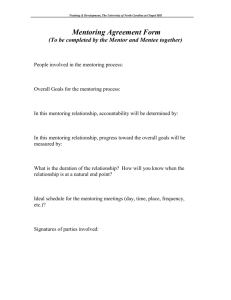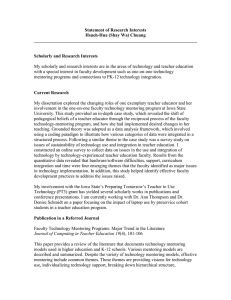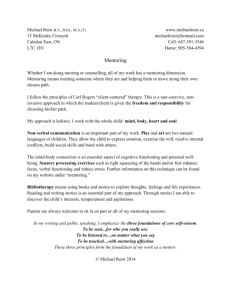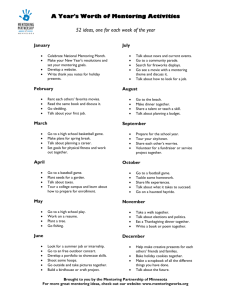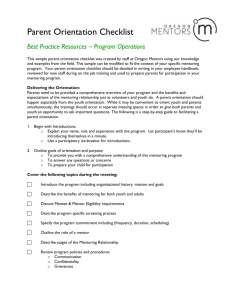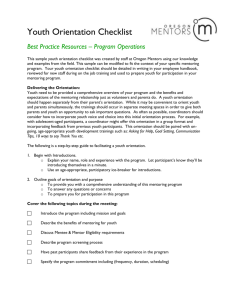Why Activity Theory?
advertisement
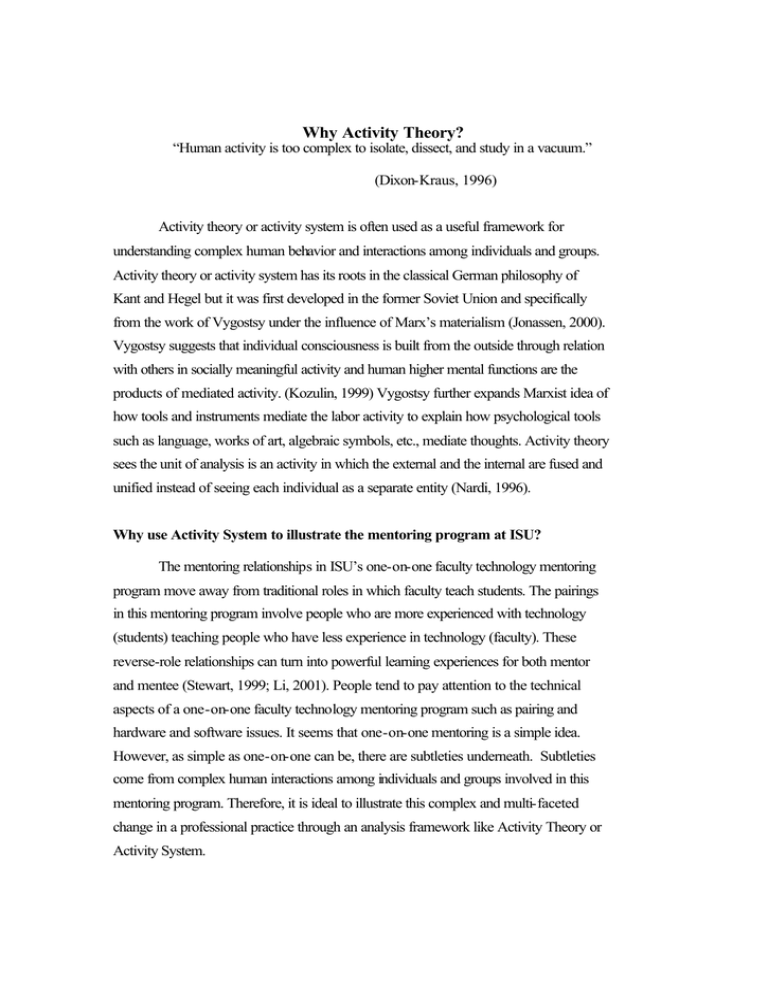
Why Activity Theory? “Human activity is too complex to isolate, dissect, and study in a vacuum.” (Dixon-Kraus, 1996) Activity theory or activity system is often used as a useful framework for understanding complex human behavior and interactions among individuals and groups. Activity theory or activity system has its roots in the classical German philosophy of Kant and Hegel but it was first developed in the former Soviet Union and specifically from the work of Vygostsy under the influence of Marx’s materialism (Jonassen, 2000). Vygostsy suggests that individual consciousness is built from the outside through relation with others in socially meaningful activity and human higher mental functions are the products of mediated activity. (Kozulin, 1999) Vygostsy further expands Marxist idea of how tools and instruments mediate the labor activity to explain how psychological tools such as language, works of art, algebraic symbols, etc., mediate thoughts. Activity theory sees the unit of analysis is an activity in which the external and the internal are fused and unified instead of seeing each individual as a separate entity (Nardi, 1996). Why use Activity System to illustrate the mentoring program at ISU? The mentoring relationships in ISU’s one-on-one faculty technology mentoring program move away from traditional roles in which faculty teach students. The pairings in this mentoring program involve people who are more experienced with technology (students) teaching people who have less experience in technology (faculty). These reverse-role relationships can turn into powerful learning experiences for both mentor and mentee (Stewart, 1999; Li, 2001). People tend to pay attention to the technical aspects of a one-on-one faculty technology mentoring program such as pairing and hardware and software issues. It seems that one-on-one mentoring is a simple idea. However, as simple as one-on-one can be, there are subtleties underneath. Subtleties come from complex human interactions among individuals and groups involved in this mentoring program. Therefore, it is ideal to illustrate this complex and multi-faceted change in a professional practice through an analysis framework like Activity Theory or Activity System. Generation 1 : Activity Theory (Vygotsky) Artifact-mediated and Object-oriented Mediating Artifact Subject Object Subject: A person or a group engaged in an activity Object: Objective held by the subject Mediation: Different types of tools such as material tools and mental tools Generation 2 Activity Theory (Leontiev) Extend the theory to separate individual actions from collective activities by adding distinction between activity, action, and operation. Three Hierarchical Levels Activity --- Upper Level Activity is driven by object-related motives Action -- Middle level Action is not an action by itself but as a coordinated part of social activity and accompanied by shared meaning of the action. Action is driven by a goal. Operation –Bottom level Operation is driven by condition or whatever tool available at hand. Third Generation Activity Theory (Engestrom) The structure of a human activity system (Engestrom, 1987, p. 78) Subject: The individual or group. The object (or objective): Target of the activity within the system. Instruments: Internal or external mediating artifacts help to achieve the object and then eventually the outcome. Community: One or more people share the objective with the subject. Rules: Actions and interactions are regulated by rules within the activity system. Division of Labor: How tasks are divided horizontally between community members. There is vertical division of power and status as well. The Activity System of One-on-one Faculty Technology Mentoring Program Themes of Successful Mentorship The themes or key elements of successful mentorship identified through a literature review paper (Chuang, et al., 2002) can be consider as strategies to resolve contradictions within the elements in a mentoring program activity system. Providing Visions for Technology Use (object) When facing the contradictions of object or objective, coordination between different versions of the object (in this case, visions for technology use) among different subjects has to be achieved to ensure the continuous operation of the system. Individualizing Technology Support (Instrument) Instruments of this activity system include a variety of hardware and software. However, the contradiction arises when the subjects have to decide whose computer to use and where the computer is available. Faculty usually prefer prefers to use their own computer in their own office where they feel most comfortable learning to advance their technology skills. Breaking Down Hierarchical Structure (Labor of division) Establishing Open Dialogue and Collaborative Relationships (division of labor) The subjects (mentors and mentees) involved in this activity system established a more horizontal division of labor (breaking down hierarchical structure), avoiding one primary contradiction of unequal status power between the faculty mentees and the student mentors (collaborative relationship). Providing Mutual Benefits ( Rule) In a one-on-one mentoring program, the primary rule is that mentor and mentee work in a one-on-one situation. The most common contradiction within this rule is that one is intentionally giving and the other is passively taking, a one-way communication and approach. Therefore, if mutual benefits can be achieved, the construction is relieved . Establishing Learning Communities ( Community) The establishment of learning communities is to break the isolation (contradiction) between each individual member of a community or among different sub-communities. References: Chuang, H., Thompson, A., Schmidt, D. (2002). Faculty Technology Mentoring Program: Major trends in the literature. Paper presented in Society for Information Technology & Teacher Education 2002. Proceedings (13th, Nashville, Tennessee, USA, March 18-23, 2002). Dixon-Krauss, L. (1996). Vygotsky in the classroom: Mediated literacy instruction and assessment. New York, NY: Longman. Nardi, B. (1996). Context and Consciousness: Activity theory and human-computer interaction. Cambridge, MA: MIT Press. Engeström, Y. (1987). Learning by expanding: An activity-theoretical approach to developmental research. Helsinki: Orienta-Konsultit. Jonassen, D. H. (2000). Revisiting Activity Theory as a Framework for Designing Student-Centered Learning Environments. In D. H. Jonassen & S. M. Land, Theoretical Foundations of Learning Environments (pp. 89-121). Mahwah, NJ: Lawrence Erlbaum Associates. Kozulin, A. (1999). The concept of activity in Soviet psychology: Vygotsky, his disciplesand critics. In Lloyd, P. & Fernyhough, C., et al (Eds). Lev Vygotsky: Critical assessment: Vygotsky’s theory, Vol. I. (pp. 179-202). New York, NY, USA: Routledge.
